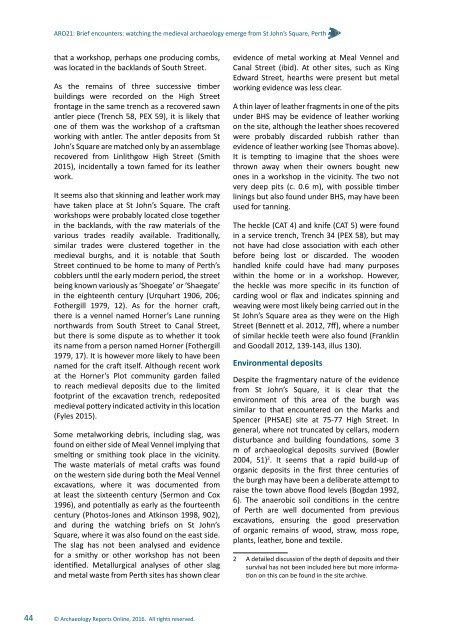medieval archaeology emerge from St John’s Square Perth
ARO21_St_Johns_Square
ARO21_St_Johns_Square
Create successful ePaper yourself
Turn your PDF publications into a flip-book with our unique Google optimized e-Paper software.
ARO21: Brief encounters: watching the <strong>medieval</strong> <strong>archaeology</strong> <strong>emerge</strong> <strong>from</strong> <strong>St</strong> <strong>John’s</strong> <strong>Square</strong>, <strong>Perth</strong><br />
that a workshop, perhaps one producing combs,<br />
was located in the backlands of South <strong>St</strong>reet.<br />
As the remains of three successive timber<br />
buildings were recorded on the High <strong>St</strong>reet<br />
frontage in the same trench as a recovered sawn<br />
antler piece (Trench 58, PEX 59), it is likely that<br />
one of them was the workshop of a craftsman<br />
working with antler. The antler deposits <strong>from</strong> <strong>St</strong><br />
<strong>John’s</strong> <strong>Square</strong> are matched only by an assemblage<br />
recovered <strong>from</strong> Linlithgow High <strong>St</strong>reet (Smith<br />
2015), incidentally a town famed for its leather<br />
work.<br />
It seems also that skinning and leather work may<br />
have taken place at <strong>St</strong> <strong>John’s</strong> <strong>Square</strong>. The craft<br />
workshops were probably located close together<br />
in the backlands, with the raw materials of the<br />
various trades readily available. Traditionally,<br />
similar trades were clustered together in the<br />
<strong>medieval</strong> burghs, and it is notable that South<br />
<strong>St</strong>reet continued to be home to many of <strong>Perth</strong>’s<br />
cobblers until the early modern period, the street<br />
being known variously as ‘Shoegate’ or ‘Shaegate’<br />
in the eighteenth century (Urquhart 1906, 206;<br />
Fothergill 1979, 12). As for the horner craft,<br />
there is a vennel named Horner’s Lane running<br />
northwards <strong>from</strong> South <strong>St</strong>reet to Canal <strong>St</strong>reet,<br />
but there is some dispute as to whether it took<br />
its name <strong>from</strong> a person named Horner (Fothergill<br />
1979, 17). It is however more likely to have been<br />
named for the craft itself. Although recent work<br />
at the Horner’s Plot community garden failed<br />
to reach <strong>medieval</strong> deposits due to the limited<br />
footprint of the excavation trench, redeposited<br />
<strong>medieval</strong> pottery indicated activity in this location<br />
(Fyles 2015).<br />
Some metalworking debris, including slag, was<br />
found on either side of Meal Vennel implying that<br />
smelting or smithing took place in the vicinity.<br />
The waste materials of metal crafts was found<br />
on the western side during both the Meal Vennel<br />
excavations, where it was documented <strong>from</strong><br />
at least the sixteenth century (Sermon and Cox<br />
1996), and potentially as early as the fourteenth<br />
century (Photos-Jones and Atkinson 1998, 902),<br />
and during the watching briefs on <strong>St</strong> <strong>John’s</strong><br />
<strong>Square</strong>, where it was also found on the east side.<br />
The slag has not been analysed and evidence<br />
for a smithy or other workshop has not been<br />
identified. Metallurgical analyses of other slag<br />
and metal waste <strong>from</strong> <strong>Perth</strong> sites has shown clear<br />
evidence of metal working at Meal Vennel and<br />
Canal <strong>St</strong>reet (ibid). At other sites, such as King<br />
Edward <strong>St</strong>reet, hearths were present but metal<br />
working evidence was less clear.<br />
A thin layer of leather fragments in one of the pits<br />
under BHS may be evidence of leather working<br />
on the site, although the leather shoes recovered<br />
were probably discarded rubbish rather than<br />
evidence of leather working (see Thomas above).<br />
It is tempting to imagine that the shoes were<br />
thrown away when their owners bought new<br />
ones in a workshop in the vicinity. The two not<br />
very deep pits (c. 0.6 m), with possible timber<br />
linings but also found under BHS, may have been<br />
used for tanning.<br />
The heckle (CAT 4) and knife (CAT 5) were found<br />
in a service trench, Trench 34 (PEX 58), but may<br />
not have had close association with each other<br />
before being lost or discarded. The wooden<br />
handled knife could have had many purposes<br />
within the home or in a workshop. However,<br />
the heckle was more specific in its function of<br />
carding wool or flax and indicates spinning and<br />
weaving were most likely being carried out in the<br />
<strong>St</strong> <strong>John’s</strong> <strong>Square</strong> area as they were on the High<br />
<strong>St</strong>reet (Bennett et al. 2012, 7ff), where a number<br />
of similar heckle teeth were also found (Franklin<br />
and Goodall 2012, 139-143, illus 130).<br />
Environmental deposits<br />
Despite the fragmentary nature of the evidence<br />
<strong>from</strong> <strong>St</strong> <strong>John’s</strong> <strong>Square</strong>, it is clear that the<br />
environment of this area of the burgh was<br />
similar to that encountered on the Marks and<br />
Spencer (PHSAE) site at 75-77 High <strong>St</strong>reet. In<br />
general, where not truncated by cellars, modern<br />
disturbance and building foundations, some 3<br />
m of archaeological deposits survived (Bowler<br />
2004, 51) 2 . It seems that a rapid build-up of<br />
organic deposits in the first three centuries of<br />
the burgh may have been a deliberate attempt to<br />
raise the town above flood levels (Bogdan 1992,<br />
6). The anaerobic soil conditions in the centre<br />
of <strong>Perth</strong> are well documented <strong>from</strong> previous<br />
excavations, ensuring the good preservation<br />
of organic remains of wood, straw, moss rope,<br />
plants, leather, bone and textile.<br />
2 A detailed discussion of the depth of deposits and their<br />
survival has not been included here but more information<br />
on this can be found in the site archive.<br />
44<br />
© Archaeology Reports Online, 2016. All rights reserved.


